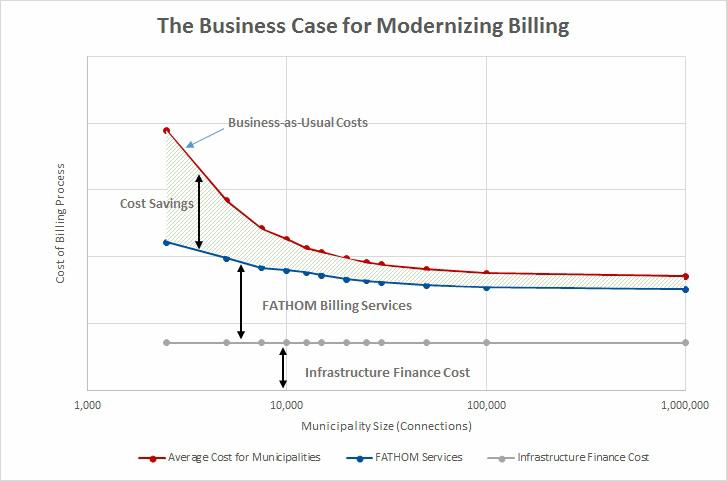Building The Business Case For The Smart Grid For Water
By Graham Symmonds, PE, chief knowledge officer, FATHOM
In our last article we introduced the strategic and direct financial benefits associated with the Smart Grid for Water. In this edition, we begin the process of developing the business case for a Smart Grid for Water installation and how to make it compelling.
By and large, utilities make decisions based on costs. And as most of our municipal utilities operate as enterprise funds, they must ensure that the costs of operations, administration, and capital improvements can be serviced by the revenue generated from utility customers. Given that water consumption is decreasing (as a function of fixture efficiency, voluntary and mandatory conservation, and increasing costs to the consumer), utilities find themselves in an increasingly tenuous financial condition. This financial instability impedes the adoption of technology, potentially isolating utilities from the benefits of the Smart Grid for Water.
It is these conditions that drive the urgency for the adoption of the Smart Grid for Water. At the intersection of the meter and customer, we can generate significant financial benefits while reducing costs, resulting in platforms that are self-funding. With this approach, utilities can get new meters, highly functional data management, billing, and customer presentment tools — all at less than the costs of providing those services today. How is this possible? By leveraging the power and economies of scale of cloud-based, software-as-a-service (SaaS) platforms, and taking advantage of the low cost of capital available in today’s market.
I Spend How Much?!
There is a myriad of activities that can go into the provision of billing and remittance management in water utilities, and understanding these “business as usual” costs is key to unlocking the potential for savings.

The cost of billing is much more than the cost of paper and stamps. Many utilities employ a cadre of meter reading staff, or use operations staff in the meter reading process. Further, the costs of customer service call centers, physical costs of truck rolls for meter reading and re-reads, maintenance and license fees for on-premise software systems, meter repair and replacement programs, insurance and administrative costs, bad debt, and collections management all add to the cost of the bill. Add in the fact that, in most utilities, customer information systems are antiquated, with customer engagement usually accomplished with significant human resources, as well as costs incurred from data errors and remediation, and we can see the costs skyrocket.
All told, the median cost of generating an invoice and getting paid in a water utility in the U.S. is in the range of $8 to $12 per account per month. That’s a staggering percentage of the customers’ actual bill. And as the utility size gets smaller (the reality of water utilities in the U.S.), the cost of this business increases — it’s a function of scale.
This represents a utility vertical that is ripe for innovation to drive the cost of service down while improving service levels and functionality.

While this situation may seem irreparable, the fact that most of the costs of performing these activities are already baked into utility financials, budgets, and rates today. We have, therefore, a source of funds to work with: by modernizing this process for less than current costs, we can liberate significant funds for continued innovation in the Smart Grid for Water.
In fact, the economics rapidly become extremely attractive, with an immediate “return on investment.”
Save Money With Better Service
The advent of software-as-a-service platforms now allows utilities to access modern, highly-functioning, and easy-to-use tools to manage billing without the investment in licenses, specialized IT resources, and dedicated server and communication hardware. Using SaaS-based systems, the costs of modernization of billing and customer service are not a long-term, complicated, and risky capital project, but an operational expense that provides high reliability, security, and guaranteed service levels for a low cost. In fact, with the appropriate solution, the costs can be less than 50 percent of what many utilities incur today.
And that frees up the funds to invest in another cost-saving component of the Smart Grid for Water: advanced metering infrastructure (AMI).
Consider a community of 12,000 connections that currently has manually read meters and has been shown to have a cost of $11 per meter per month. Under a SaaS services model, the real costs for putting a bill out the door and managing the billing/remittance process can be reduced by 20 percent or more — including the cost of capital for new metering infrastructure.
As a result, for a total cost in the order of $9 per meter per month, the utility actually saves $2 per meter per month in their billing process. That’s $288,000 annually that can be invested in system improvements, replacing aging infrastructure or other efficiency-generating projects, while receiving the benefit of new infrastructure, new billing systems, and improving the customer-utility interaction.
The adoption of AMI drives further efficiencies into the utility. While AMI eliminates the costs of routine meter reading, more importantly, when combined with geospatial meter data management, it increases the accuracy and precision of the meter read, reducing re-reads and re-work. The result is 100 percent accurate and timely reads ready for billing at all times, and identification of failed and failing meters well before billing, improving the utility’s cash flow.
And this is before the found revenue aspects of the Smart Grid for Water and the impact of these systems on the cash flow of the utility are realized.
That’s the subject of our next edition: finding revenue in your data.
